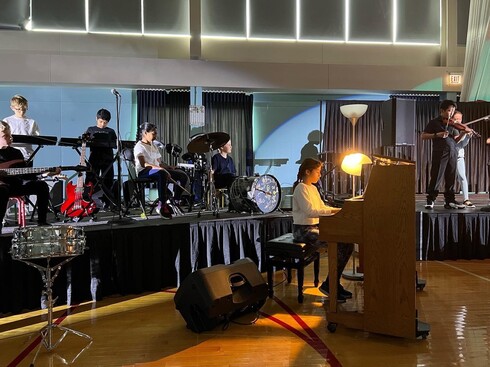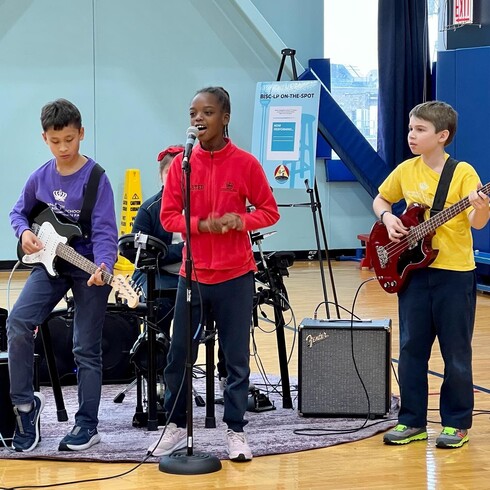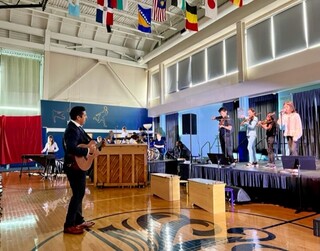We use cookies to improve your online experiences. To learn more and choose your cookies options, please refer to our cookie policy.

Hey music lovers!
Let’s take our love of music to the next level. Here are the best ways to foster a love of music in students and encourage them to keep playing and singing for years to come.
First things first, let's talk about the importance of variety. A well-rounded music education is essential, and that means exposing students to different styles, cultures, and historical periods. Think of it like a musical buffet - there's something for everyone! From the classical masterpieces of Beethoven and Bach to the latest pop and hip-hop hits, students will learn to appreciate the diversity and richness of music. The more options students have, the more likely they are to find a genre or style that resonates with them.

But just listening to music isn't enough - students need to get in on the action too! Giving students the opportunity to participate in music-making through singing, playing instruments, and composing is crucial for developing a deeper connection to music. Studies have shown that actively engaging with music can have a powerful impact on mental and emotional well-being, and that's not to mention the sheer joy of creating music themselves.
Now, creating a positive and inclusive learning environment is key. The class should be a supportive and encouraging space where students feel free to explore their creativity and express themselves through music. But don't forget the importance of discipline and work ethic, these are important in order to become proficient in music.
Another important aspect of fostering a love of music in students is tailoring education to their individual needs and learning styles. This allows them to work at their own pace and build on their strengths. This can mean incorporating different teaching methods, such as incorporating music into other subjects like language arts, science, and social studies, or using movement and dance to help students understand rhythm, beat, and melody. Or for more creative students, providing opportunities for composing their own songs or creating their own accompaniments to familiar songs.
But music education doesn't have to end at the classroom. Connecting students with opportunities to pursue music outside of the school can be beneficial too. Community music programs and summer camps are great places to start. And for those who want to pursue music in college or as a career, providing information about college music programs or career opportunities in music can help them make informed decisions.
Incorporating music technology, like digital audio workstations (DAWs) and music notation software, into the curriculum can be a great way to provide students with the technical skills they need to compose and record their own music, students will also be exposed to digital music-making tools and develop digital literacy skills.
By incorporating community and multicultural musical experiences, students will be exposed to different musical styles and cultures, allowing them to learn about different art forms and cultures, and appreciate music as a medium for communication and expression.
Using a project-based learning approach is also an effective way to give students a sense of purpose. Setting performance goals and giving them opportunities to demonstrate their learning and understanding can be extremely motivating and effective.
In short, fostering a love of music in students is all about providing a holistic, engaging, and personalized music education that allows students to explore, create, and connect with music in their own way.
Parents can play an important role in supporting school music teachers by encouraging their children's participation in music classes and activities, providing resources for music practice, attending school music performances, and creating a positive and encouraging environment for learning music. Together, we can help students fall in love with music and develop skills and passion for the performing arts.
As students develop their musical skills, it's also important to provide opportunities for them to perform and showcase their talents. Formal performances and concerts, whether in the classroom or in the community, can be a great way for students to apply what they've learned and gain confidence in their abilities. It also helps them understand the importance of practice, discipline and hard work, which can carry over to other areas of their lives.
Additionally, providing access to a variety of instruments and resources can also make a big difference. Whether it's school-owned instruments or rental programs, giving students access to a variety of instruments can help them find their passion and develop their skills. And with the use of technology, students can have access to many resources, such as sheet music, tutorials, and videos that can enhance the learning experience.
Another important consideration is the value of music as a means of self-expression and personal growth. Music can be a powerful tool for communication and can be used to process emotions and experiences. Encouraging students to use music as a form of self-expression can help them understand the power of music and develop their own voice as musicians.

In conclusion, fostering a love of music in students requires a multifaceted approach. From providing a well-rounded education, to giving students opportunities to participate in music-making, and providing access to resources, it's important to create an environment that is engaging, supportive, and tailored to each student's needs. And with the help of parents, educators, and community programs, students will be able to explore, create, and connect with music in their own way, and the love of music will be instilled in them for life.
Here is a list of real-life repertoires of different genres of music that you and your child can listen to together:
This is a list of a few examples; many more can be found in each of the genres. It's also important to note that our students at BISC-LP have access to Juilliard curated repertoires in the form of Core Works. You can find them on our website under the Juilliard collaboration tab.
Christian Fernandez
Music Specialist